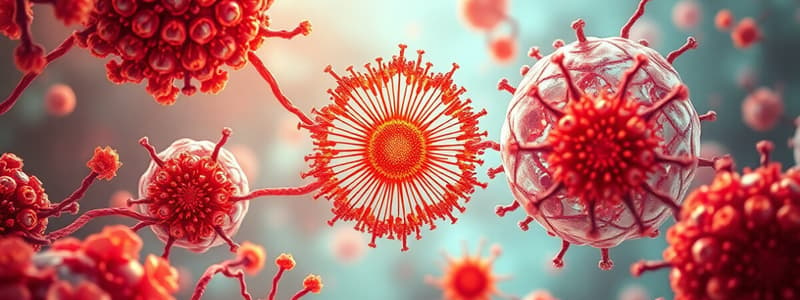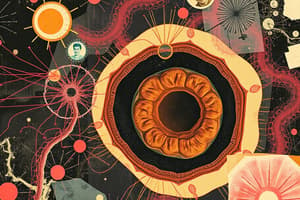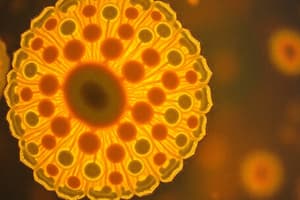Podcast
Questions and Answers
Which structure is responsible for the cell's energy production?
Which structure is responsible for the cell's energy production?
- Endoplasmic Reticulum
- Golgi Apparatus
- Nucleus
- Mitochondria (correct)
What is the primary function of lysosomes?
What is the primary function of lysosomes?
- Transport materials within the cell
- Modify and package proteins
- Store water and salts
- Break down substances and recycle waste (correct)
Which structures are found in eukaryotic cells but not in prokaryotic cells?
Which structures are found in eukaryotic cells but not in prokaryotic cells?
- Ribosomes
- Cell membrane
- Cytoplasm
- Nucleus and membrane-bound organelles (correct)
What type of endoplasmic reticulum has ribosomes attached to its surface?
What type of endoplasmic reticulum has ribosomes attached to its surface?
What is the main function of the Golgi apparatus?
What is the main function of the Golgi apparatus?
Which structure assists in cell movement and provides support?
Which structure assists in cell movement and provides support?
What is the primary composition of the cell membrane?
What is the primary composition of the cell membrane?
Which of the following is NOT a function of vacuoles in plant cells?
Which of the following is NOT a function of vacuoles in plant cells?
Flashcards
What is a prokaryotic cell?
What is a prokaryotic cell?
A primitive cell lacking a nucleus and membrane-bound organelles. It's considered to be the first cell type to evolve.
What is a eukaryotic cell?
What is a eukaryotic cell?
A complex cell with a nucleus and membrane-bound organelles, found in plants and animals. It's more advanced than a prokaryotic cell.
What is the function of the cell membrane?
What is the function of the cell membrane?
The cell membrane isolates and protects the cell's interior. It is composed of a phospholipid bilayer, two layers of phospholipids arranged in a membrane.
What is cytoplasm?
What is cytoplasm?
Signup and view all the flashcards
What is the cytoskeleton?
What is the cytoskeleton?
Signup and view all the flashcards
What is the function of the nucleus?
What is the function of the nucleus?
Signup and view all the flashcards
What is the endoplasmic reticulum (ER)?
What is the endoplasmic reticulum (ER)?
Signup and view all the flashcards
What is the function of ribosomes?
What is the function of ribosomes?
Signup and view all the flashcards
Study Notes
Cell Structures and Functions
-
Cell Types: Eukaryotic cells (plants and animals) are more complex than prokaryotic cells, possessing a nucleus and membrane-bound organelles. Prokaryotic cells are simpler and predate eukaryotic cells, lacking a nucleus.
-
Cell Membrane: A phospholipid bilayer, it isolates and protects the cell's internal environment.
-
Cytoplasm: A jelly-like substance filling the cell interior, it contains organelles and transports materials. Cytosol, the fluid portion of the cytoplasm, plays a vital role in this transport.
-
Cytoskeleton: A network of fibers (microtubules and microfilaments) supporting cell structure and enabling movement.
-
Nucleus: The control center, containing DNA (chromatin/chromosomes), the nucleolus (ribosome assembly), and a porous nuclear envelope (made of phospholipids). The nucleus regulates gene expression and protein synthesis.
-
Endoplasmic Reticulum (ER): A network of membranes involved in transporting proteins and other molecules. Rough ER has ribosomes, while smooth ER does not.
-
Ribosomes: Tiny particles composed of RNA and protein, ribosomes are the protein-synthesis machinery of the cell, assembling amino acids.
-
Mitochondria: The "powerhouses" of the cell, responsible for cellular respiration. They break down glucose to release energy for cellular functions.
-
Lysosomes: Contain enzymes that breakdown cellular waste products and debris. They are the cell's cleanup crew and recycling center.
-
Golgi Apparatus: Processes, modifies, and packages proteins for secretion or use within the cell. It acts as a customization center for proteins.
-
Vacuoles: Fluid-filled sacs for storage. Plant cells have a much larger central vacuole, crucial for water storage.
-
Cell Walls (Plants): Rigid structures providing protection and support. Primarily composed of cellulose.
-
Chloroplasts (Plant): Specialized organelles responsible for photosynthesis. They contain chlorophyll, giving plants their green color. These organelles convert light energy into chemical energy (glucose).
Studying That Suits You
Use AI to generate personalized quizzes and flashcards to suit your learning preferences.



